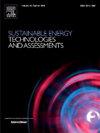Effect of blade and tower interference on wind turbine tower vibration occurred before grid connection
IF 7.1
2区 工程技术
Q1 ENERGY & FUELS
Sustainable Energy Technologies and Assessments
Pub Date : 2025-03-27
DOI:10.1016/j.seta.2025.104290
引用次数: 0
Abstract
The towers of large-scale wind turbines often experience low-frequency oscillations in the months before grid connections, threatening the turbines safety. The NREL offshore 5 MW wind turbine is investigated using computational fluid dynamics, to investigate oscillation mechanisms involving blade-tower interference. The multibody dynamics method is used to study the vibration response induced by two vortices. The results reveal that the interaction of tower and blade trailing vortices forms a larger vortex street, increasing the size and deviation of the tower’s trailing vortex. The merging of wake vortices reduces the shedding frequency, intensifies the dynamic response of the overall structure, and results in a 6-fold pressure increase exerted on the tower surface, consequently the vortex-induced resonance effects are strengthened. The lift force induced by the blade and tower trailing vortice is substantially increased and larger than that conventionally induced by a single tower’s trailing vortex. At a wind speed of 6 m/s, the maximum lift coefficient amplitude is increased by six-fold. Two-vortices interference makes vibration particularly severe at yaw angles from 40° to 50°. At 50° yaw angle, the torque at tower bottom is seven times larger than that in the nonyaw case, with lateral displacement reaching 0.97 m and forward–backward displacement reaching 0.60 m.
风电机组并网前叶片与塔架干扰对塔架振动的影响
大型风力发电机组塔架在并网前几个月经常出现低频振荡,对机组安全构成威胁。利用计算流体动力学方法对NREL海上5mw风力发电机进行了研究,研究了涉及叶片-塔架干扰的振荡机制。采用多体动力学方法研究了双涡引起的振动响应。结果表明:塔架尾涡与叶片尾涡的相互作用形成了较大的涡街,增大了塔架尾涡的大小和偏差;尾流涡的合并降低了脱落频率,增强了整体结构的动力响应,使塔面压力增加了6倍,从而增强了涡致共振效应。叶片和塔尾涡诱导的升力大大增加,并且比传统的单个塔尾涡诱导的升力更大。风速为6 m/s时,最大升力系数幅值增加了6倍。双涡干涉使偏航角从40°到50°的振动特别严重。在50°偏航角时,塔底扭矩是非偏航情况下的7倍,横向位移达到0.97 m,前后位移达到0.60 m。
本文章由计算机程序翻译,如有差异,请以英文原文为准。
求助全文
约1分钟内获得全文
求助全文
来源期刊

Sustainable Energy Technologies and Assessments
Energy-Renewable Energy, Sustainability and the Environment
CiteScore
12.70
自引率
12.50%
发文量
1091
期刊介绍:
Encouraging a transition to a sustainable energy future is imperative for our world. Technologies that enable this shift in various sectors like transportation, heating, and power systems are of utmost importance. Sustainable Energy Technologies and Assessments welcomes papers focusing on a range of aspects and levels of technological advancements in energy generation and utilization. The aim is to reduce the negative environmental impact associated with energy production and consumption, spanning from laboratory experiments to real-world applications in the commercial sector.
 求助内容:
求助内容: 应助结果提醒方式:
应助结果提醒方式:


